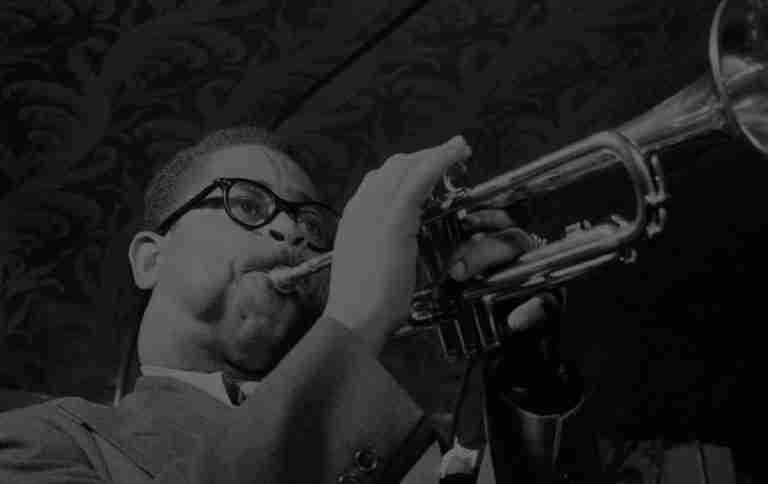Scales can be one of the most overwhelming parts of learning jazz improvisation. Between you and me, it can seem like there’s a scale to learn for every chord, a scale for every progression, and a scale for every day of the week…
However, as you’ve probably realized in the practice room, scales are not always the secret to a great solo.
But what if I told you that there were a few scales that are essential for every serious improviser to know?
Scales with inherent melodic and harmonic devices that can be used in any solo and when practiced correctly, will give you valuable techniques for mastering the jazz language.
I’m talking about the bebop scale. And in today’s post we’re going to put this scale under the magnifying glass and turn it inside out to show you everything you’ve ever wanted to know.
So if you’ve been stuck wondering how to create long flowing lines in your solo or are frustrated with the same old boring ideas, this one’s for you…
The basic Bebop Scale
I’m guessing you know the bebop scale.
You’ve seen it in books, your teachers have told you to learn it and you probably even know it in a few keys…


So what’s the big deal? Well, the true value of the bebop scale is revealed in it’s potential for creating melodies over chord progressions.
The chromatic movement surrounding the flat 7th of this scale creates a natural melodic motion that emphasizes the root and flat 7th of the underlying V7 chord:

This device can be found in the solos of every great improviser from Louis Armstrong and Charlie Parker to Freddie Hubbard, Michael Brecker and the improvisers of today.
And this chromatic motion over V7 chords is essential for mastering the jazz language, in fact it can become one the most useful tools you have in creating longer melodic lines in your solos.
However, the unfortunate thing about the bebop scale is that most players treat it as just another scale to memorize and drill in the practice room – but this is only the beginning.
Today we’re going to show you why the dominant bebop and major bebop scale can unlock your melodic potential. Beyond another scale option over V7 chords, you’ll learn some key techniques that can be used on any solo or chord progression you encounter.
Getting started: The bebop scale over V7 chords
The most common way to use the bebop scale is over dominant 7th chords…
Practice applying the bebop scale to static dominant chords. Think of the Blues, the bridge to Rhythm Changes, or any number of jazz standards with dominant chords that last for a measure or longer.
Each of these spots is an opportunity to use the linear motion of the bebop scale to create a melodic line. Check out this line from Joe Henderson’s solo on the tune Totem Pole:

Over an F7 chord he plays a descending F bebop scale. Because of the chromatic movement in the scale, the 3rd and b7th of the F7 chord are emphasized in a melodic way. But there is one important thing to notice here: he starts on the 5th of the scale instead of the root.
Just like a major scale, you shouldn’t only think of the bebop scale as root to root. Instead envision a sequence that spans the entire range of your instrument.

To be truly effective with this scale you need to be able to start on any note of the scale throughout the entire range of your instrument.
And for more exercises like the ones below, make sure to check out our course that gives you a ton of different soloing tools, Melodic Power.

In the practice room try starting on the 3rd, the 5th or even the b7 of the bebop scale – ascending and descending from each scale degree:
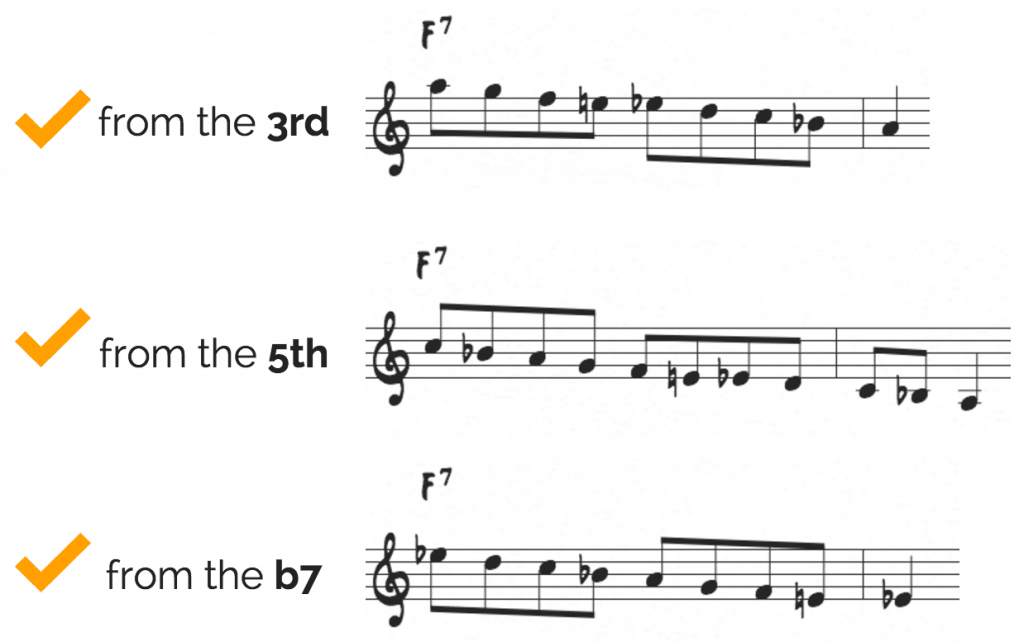
Master it in every key. Along the way you may have to focus on and isolate the root to b7 motion of the scale to get it under your fingers. Focus on the tricky keys and repeat the pattern until you can play it in your sleep.

As you do these exercises be aware of what scale degree you’re landing on and aim to end or resolve your line on different chord tones. In your solos the direction of your line will depend on the next chord – Is the line going to the I chord, another V7 chord, a minor chord, a tritone sub?
Apply the melodic motion of this scale to the V7 chords in your solos
After you’ve ingrained the basic scale try applying it to the bridge of Rhythm Changes or the Blues. A good exercise is to use the bebop scale over the first four bars of the blues progression:

Along the way study how your favorite players approach this scale melodically and rhythmically in their playing. For example listen to this Freddie Hubbard line over the first 4 bars of his blues Birdlike.
Over the F7 he plays a descending F bebop scale starting on the b7:

Remember, you don’t have to use the entire scale…
The trap that many players fall into with practicing scales is that they develop melodic and harmonic tunnel vision.
When it’s time to improvise all they can see is that one scale they’ve spent hours practicing. It could be a C7 chord, a ii-V7 progression or even an entire tune, yet they are stuck trying turn 8 notes into a solo…

Unfortunately this approach is not going to make music – it’ll end up sounding like a music theory exercise.
Don’t fall into this trap with the bebop scale. The secret to sounding good comes in how you apply this scale to your solo in a musical way. Turning a practice exercise into musical language that people will actually want to listen to.
Remember, the point of practicing the bebop scale is not to insert the entire scale into your solos, rather to use this material you’ve learned as a tool in creating musical lines.
You have to hear the musical information that you’re learning in context.

Once mastered, the bebop scale can serve as a starting point for a piece of language that you already know or a transition to upcoming chords.
And this is where you’ll find the melodic characteristic of the scale most useful. You can use a fragment of the scale or even the chromatic movement of the major 7 to b7 to accentuate goal notes or approach chords.
To see what I mean, let’s look at some examples. The bebop scale is particularly useful in emphasizing the b7 or 3rd of dominant chords. Here are 3 examples of this technique over an F7 chord:
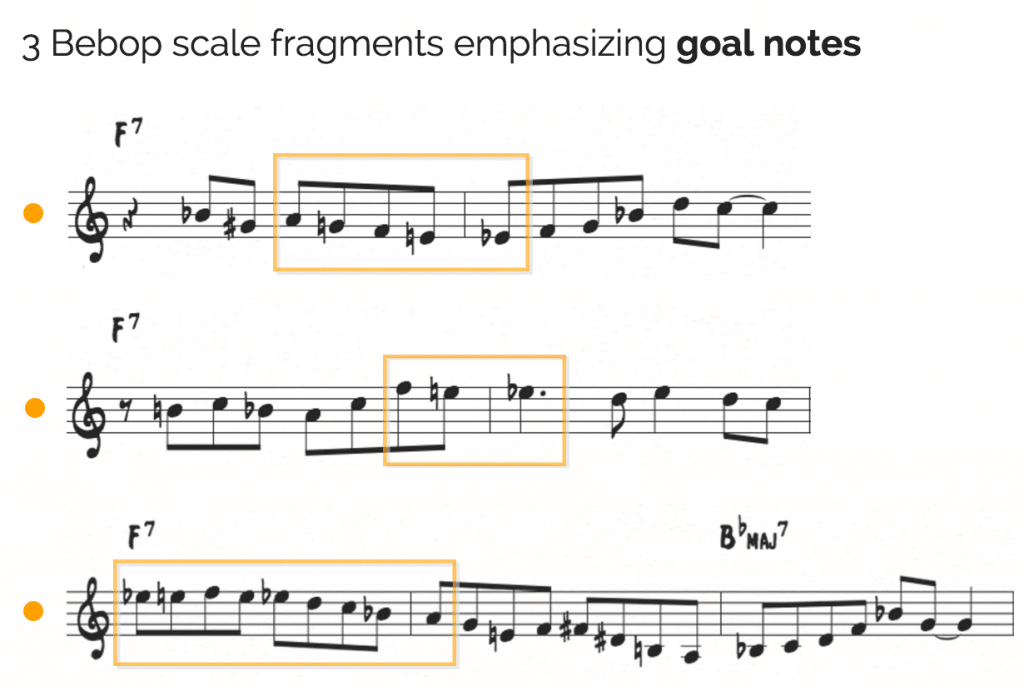
As shown in the examples above, experiment with using techniques like enclosures or approach notes to start your lines and incorporate alterations and substitutions along with these scale fragments.
Once you feel comfortable applying the bebop scale to dominant chords, try approaching an upcoming dominant chord with a bebop scale.
Listen to this excerpt of Clifford Brown’s solo on Cherokee, anticipating the arrival of the C7 chord with a bebop scale fragment:

Here he uses the C bebop scale as a way to lead into the upcoming C7 chord. In this line, the goal note is the 5th (G) of the C7 chord.
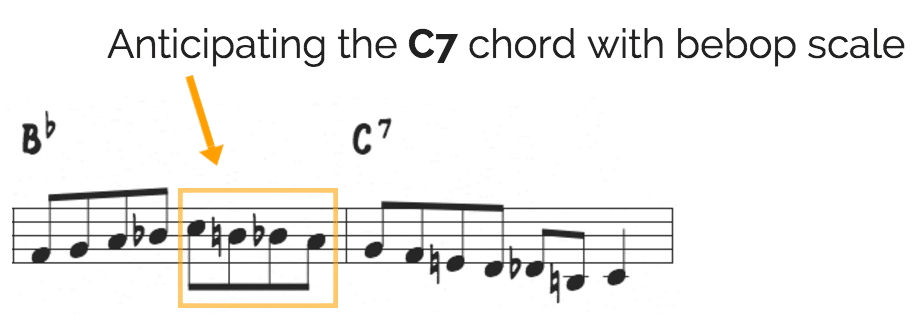
As you’ll see the more you transcribe solos and study the jazz language, even a fragment of the bebop scale can be effective in creating melodic or forward motion in your solos.
Here’s another example of this technique from Charlie Parker’s solo on Cherokee:

He uses the motion of a D bebop scale to start his line, anticipating the D7 chord and aiming for the 3rd of the chord.
Applying the bebop scale to different chords…

The bebop scale and it’s inherent chromatic movement don’t have to be limited to V7 chords…
You can also apply this melodic concept to a number of other chords. Taking this familiar scale and approaching it in new ways – and this is where things get interesting.
And we’re going to show you some of these other chords, but keep in mind that if you had a deep knowledge of jazz harmony, you’d understand how to apply the bebop scale in limitless ways.

One of my favorite examples of the bebop scale in action is from Mulgrew Miller’s solo on Bill Mobley’s reharmonization of The Touch of Your Lips:
At around 2:00 minutes in, over what is essentially an extended G7sus or CMaj sound, Mulgrew plays the following line:

The underlying chords look like this: [ Gsus2/F | A-sus2/G | Fsus2/A | Gsus2/E ] and Mulgrew navigates this progression in a melodic way with the G bebop scale.
This is a great example showing that the bebop scale can be used as a melodic device over a number of different chords, aside from the traditional dominant chord. And as you’ll see, this is something that all great improvisers do in their solos.
Let’s take a look at 3 examples…
3 ways to use the bebop scale over different chords
You know you can use the bebop scale on dominant chords…
But the true versatility of this scale comes in applying it to the other chords in your solos. Below we’ll show you 3 ways that you can apply bebop scales to different chords:

The first alternative way you can use the bebop scale is on minor chords. Over a minor chord you can access this sound by playing a bebop scale or shape a 4th above the root, essentially implying a ii-V7 progression over a static minor chord:
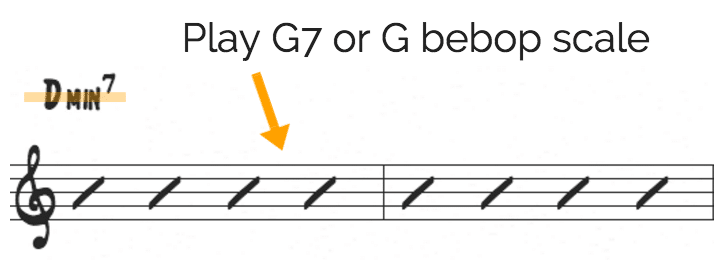
For example you can imply G7 over a D minor chord, utilizing your G7 language or the G bebop scale over this chord.

The chromatic movement of the bebop scale emphasizes the minor 3rd and 13th of the minor chord. Check out how Freddie Hubbard uses this technique with a Db bebop scale over an Ab-7 chord in his solo on Dolphin Dance:

A great way to practice this technique is by visualizing minor chords around the cycle and thinking of the related bebop scale.

The next way you can apply the bebop scale to the chord progressions of tunes is over half-diminished chords.
To access this sound you’ll play a bebop scale from the b6 of the half-diminished chord – for example, over a B-7b5 chord you would use a G bebop scale:
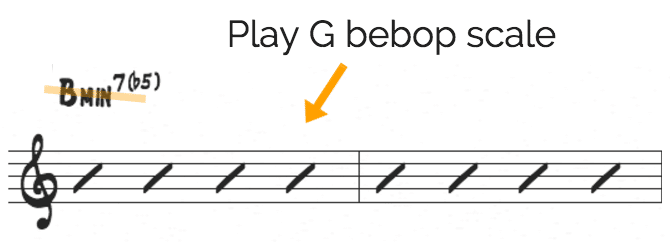
With this scale you highlight the root, minor 3rd and flat 5th of the chord:
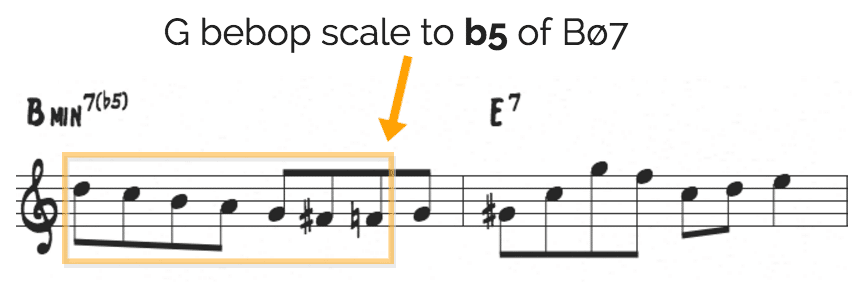
A great way to use this technique is over minor ii-V’s. Check out how Bill Evans utilizes this sound over a half-diminished chord on Woody n’ You, starting his line with a bebop fragment from the b6:

He creates a sequence with the bebop scale fragments. Combining multiple of the bebop scale within one line:

Again, the faster you can visualize the b6 of a half-diminished chord and the related bebop scale, the more adept you’ll be at utilizing this scale in your solos.

The dominant sus chord often causes some confusion for improvisers.
Without the 3rd of the chord in the sus voicing it can be tricky to figure out how to approach these chords. But it’s something that you need to know, especially if you plan on playing tunes like Maiden Voyage, One Finger Snap, or Passion Dance…
A great way to navigate this sound is with a bebop scale:
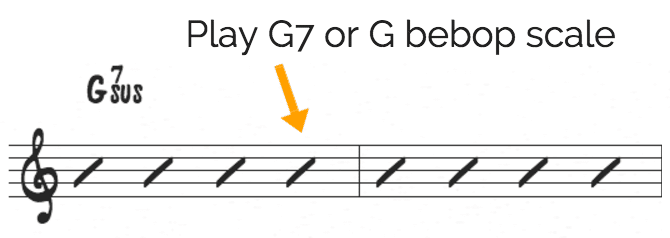
Because it is an open sound you can imply a number of different harmonic techniques. One option over this sus chord is using the bebop scale to imply a V7 chord or even ii-V language:

Check out how Freddie Hubbard uses the bebop scale over an Ab7sus chord in his solo over One Finger Snap, combining the Ab bebop scale with related Eb- language:

Master the bebop scale and its applications and you’ll have a technique that you can apply to Dominant, minor, half-diminished, and sus chords.
And as we’ll show you below…even ii-V’s.
Using the bebop scale over ii-V’s
The next way you can use the bebop scale is over the ii-V-I progression.
One technique that many great players use is approaching a ii-V by thinking only of the V7 chord. For example thinking G7 over a D-7 – G7 progression and applying a G bebop scale:

A great example of this is from John Coltrane’s solo on Giant Steps:

Over a ii-V7 to Eb (F-7 to Bb7) he is simply thinking of a Bb7 chord for the entire measure and applying a descending Bb bebop scale.
With this motion, the root of the Bb bebop scale resolves to the 5th of the I chord.
Here’s another example of Trane applying this concept to the first 2 bars of Rhythm Changes. Over the ii-V7 he plays an F7 bebop scale:

Check out how Sonny Stitt applies this same technique with the bebop scale in a sequence on the bridge to The Eternal Triangle:

Over the chromatically descending V7 chords on the bridge he uses a sequence of bebop scales descending from the root of each V7 chord.

Notice how he anticipates the arrival of each chord by a beat or two beats.
Here’s a quick test: Now that you have the sound of the bebop scale in your ear, take a listen to Coltrane’s solo on Lazy Bird and see if you can identify where he is using it in his solo:
As you can see, the bebop scale has many melodic and harmonic applications for your solos, but it’s not the only bebop scale that you can use…
Mastering the Major Bebop Scale
The other bebop scale that you need to know is the major bebop scale.


The b6 is an effective passing tone to add melodic motion to your solos over major or dominant chords.
The addition of the b6 creates natural voice leading within the scale that lends a melodic character:

And this is a melodic technique that you can apply to any solo…
The more that you listen to great improvisers, the more you will see this pattern over and over again. A great example of this scale in action is the opening to John Coltrane’s solo on Moment’s Notice:

Over an Eb Major 7 chord he simply starts on the root and plays down an Eb major bebop scale. And because of the inherent voice leading (chromaticism) the scale sounds melodic.
Step one to using this scale in your solos is ingraining it in every key:
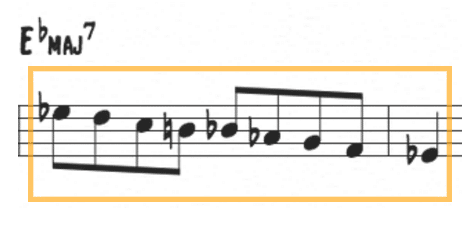
Practice the major bebop scale ascending and descending in all keys. And like the dominant bebop scale, practice isolating the chromatic motion of the scale.
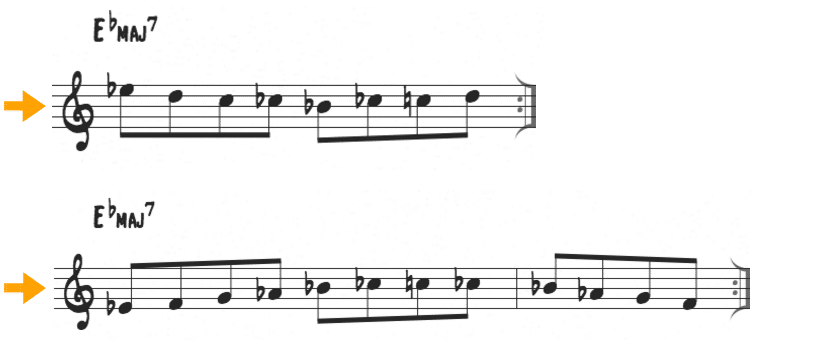
Applying the Major Bebop Scale to major 7th chords
Once you have it mastered, the next step is to incorporate this scale or utilize the b6 to 5 motion in your solos. Let’s look at how some of the best improvisers utilize this sound…
Here’s a great example of Mulgrew Miller using the major bebop scale on a Major 7 chord from his solo on If I Should Lose You:

Notice how in the second bar Mulgrew moves from the root of the chord directly to the b6 and resolves to the 5th. As you listen, you’ll hear this motion over and over again, so be sure to practice this movement along with the motion of the full scale.
Another good model to follow is this line from Michael Brecker’s solo on What is this thing called love?:

Over a DMaj7 chord he encloses the root and runs down the major bebop scale to the 5th. When paired with arpeggiation, the major bebop scale is a great way to create linear motion over major 7th chords.
Check out how Tom Harrell also plays a nearly identical line over Rhythm Changes in Bb:

By using the major bebop scale along with enclosures, you’ll be able to create long melodic lines in a very simple and easy way.
Wait a second…why does this scale work?

Let’s take a quick time out.
You’ve probably noticed that you can’t play a major scale over a major chord.
Or that when you do, something just sounds off. This is because it comes down to an issue of alignment.
Specifically aligning the downbeats of the measure with the strong chord tones of the chord. For example, if you try to play a descending C Major scale over a CMaj7 chord you’ll get this:

As you can see, the emphasis or downbeats happen on the wrong chord tones of the CMaj7 chord: the 4th, 6th and 9th. And this will make your line sound “off.”
However, if you add in the b6 passing tone to that C Major scale it’ll look like this:

When you add a chromatic note (i.e. play the major bebop scale) it allows you to land on the strong chord tones on the downbeats, emphasizing the root, 3rd and 5th of the chord.
Now the melodic line is defining the tonality and the chromatic notes are emphasizing the strong chord tones through half-step resolution.
This should sound like music to your ears.
Using the Major Bebop scale over V7 and Major chords
You can utilize the major bebop scale or the b6 to 5 motion over Major and Dominant chords. Using this chromatic note is a great way to hit the “right notes at the right time.”
Listen to how Charlie Parker uses the major bebop scale over the blues in his solo on Bloomdido:

In this passage he uses a major bebop fragment approached with an enclosure and connects this line to his turnaround language:

Here’s another example. In the line below Bill Evans utilizes the b6 to 5 movement over both V7 and Major chords in his solo over Autumn Leaves:

Over the F7 chord he uses the Db (b6) as an approach note to an F major scale fragment and over the EbMaj7 chord he uses a major bebop fragment to approach the 5th.
Finally check out how Mulgrew Miller uses the b6 in this line over the melody to If I Were a Bell:

Keep in mind that you don’t have to play the entire scale. By ingraining this pattern into your technique you can imply a bebop fragment over major or dominant chords.
Practice applying this technique of adding the b6 to Major and Dominant chords in your solos.
Where to go from here…
As you can see, the possibilities for using the bebop scale and applying the chromatic & melodic techniques within these scales are endless.
So start slow and ingrain one key at a time.
As you head into the practice room, keep these main points in mind:
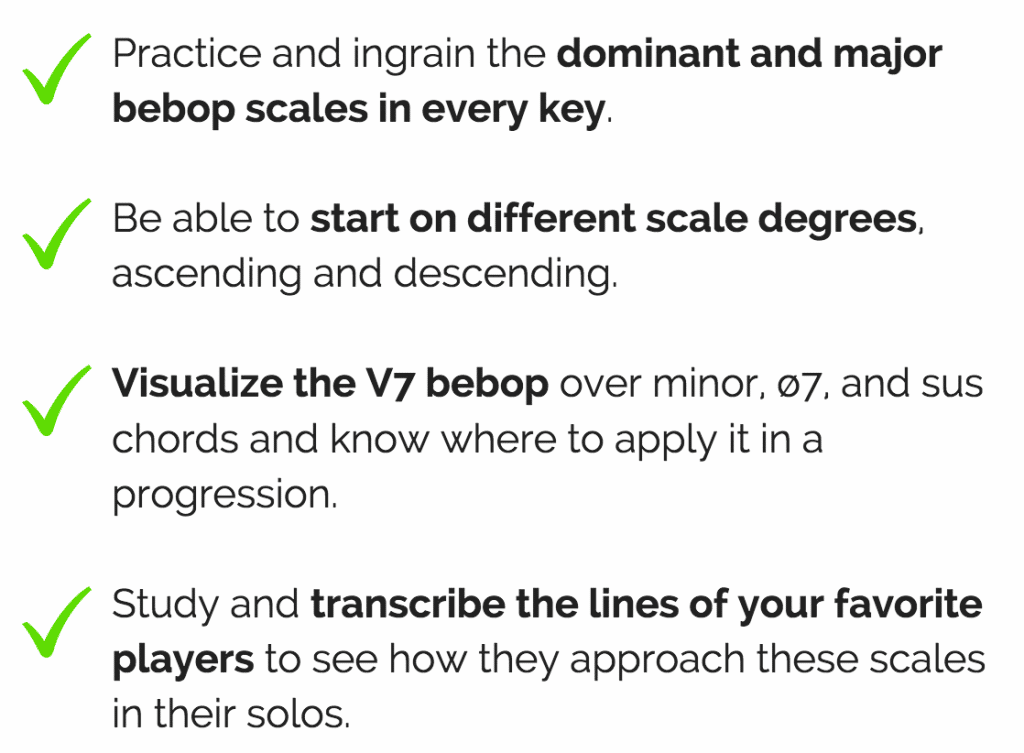
With a little bit of practice, you’ll quickly gain solid techniques for V7 and Major 7 chords in every key – going from a scale in the practice room to musical language that you can apply to any solo.
